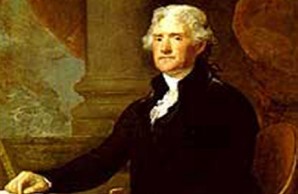Thomas Jefferson’s Contributions to Natural History
His effort sent out the Lewis and Clark exploring party into the unknown West.

Thomas Jefferson, c.1821
The fact that Thomas Jefferson’s best service to mankind was political has limited the world’s estimate of his greatness to one contribution of his useful life. That he was the preeminent statesman of his day as today he is the dominating influence surviving from the first years of the republic, was not owing to a predilection for politics but to his answering the need for a great constructive and safely guiding genius at the beginning of our independent national life. He rejoiced, instead, at the prospect of the studious life. His letters abound in expressions of his desire to retire from the arena in which he was the most notable figure. The one to Dupont de Nemours is often quoted: “Within a few days I retire to my family, my books and farms. . . . Nature intended me for the tranquil pursuits of science, by rendering them my supreme delight.”
Jefferson had a more or less scholarly acquaintance with mechanics, astronomy, meteorology, physics, civil engineering, surgical anatomy, geology, zoology, botany, economic entomology, aeronautics, and paleontology.
And by science he meant more than men do now. It included more than observed facts systematically classified and brought under general laws—he meant by it all that was connoted by the word scientia in the days of its widest acceptation. He was an eager student—going into every field open to him. It would not do to claim profound scholarship for him in all instances; his interests were too catholic, and limitations of time and opportunity so restrained him that the thoroughness of the specialist, often meticulous, was not within his reach. But he had a more or less scholarly acquaintance with mechanics, astronomy, meteorology, physics, civil engineering (mensuration, strength of materials), surgical anatomy, geology, zoology, botany, economic entomology, aeronautics, and paleontology.
While this list transcends in some instances the limits to which “science” is confined by present day definition and intrudes upon the domain of the industrial arts, it is far from embracing all that Jefferson would have included in the meaning of science, scientia, the derivative of all information and skill. His science enabled him to invent a plow, indeed the plow, to construct a barometer, a thermometer, a wind gage, a duplicating writing machine, and what not; to realize West Point for the nation and the National Observatory, to build the University of Virginia and inform it with a spirit and purpose hitherto disregarded.
The student who takes to the highways and byways of knowledge is sure to find wherever he penetrates that Mr. Jefferson has passed along before him with more or less careful observation. After twelve years of faithful, scholarly work in rediscovering and determining the truth of Latin and Celtic accent and rhythm and showing that our traditional rule of Latin pronunciation is at variance with the obvious usage of Latin verse, Professor Thomas Fitz-Hugh, of the University of Virginia, turned in pursuit of another object—for he had published the results of his own discovery—to Jefferson’s essay, Thoughts on English Prosody, and found that he had been anticipated by Jefferson by more than a century, and that nobody had seemed to know it! While Jefferson was the first to assert and use the principle that the pronunciation of an ancient speech cannot contradict the known rhythm of its poetry, Fitz-Hugh has used the principle to reveal a new world of accent and rhythm in Latin and Celtic and to expose the error of the current theory in both fields. “It is well worth while,” Professor Fitz-Hugh warns, “for the scholar and technical scientist of today to examine Jefferson’s reflections upon any field of investigation in which he allows himself to make excursions.”
And so Buffon thought long ago. He had announced his conviction that animals common to the Old and the New worlds are smaller in the latter, that those peculiar to America are smaller, that those domesticated in both have degenerated in the New world, and that the western world has fewer species. Mr. Jefferson collected data and upon ascertained facts based three tables in which he contrasted aboriginals (1) of both the Old and the New worlds, (2) of only one, and (3) of those domesticated in both. The first table showed that of the twenty-six quadrupeds common to both America and Europe, seven are larger in America, seven are of equal size, and as to twelve the facts were not decisive; the second showed that eighteen quadrupeds are peculiar to Europe and seventy-four to America, while one of the American quadrupeds—the tapir—weighs more than all the eighteen of Europe together; and the third failed to sustain Buffon’s theory of animal degeneration in the New world. He did not stop here, but had the bones and skin of the largest moose obtainable, the horns of the caribou, elk, deer, spike-horned buck, and some other large animals sent to Paris. Buffon was convinced, and said to the Virginian: “I should have consulted you, Sir, before publishing my Natural History, and then I should have been sure of my facts.” It is scarcely worth while to inquire whether the great Frenchman was pleased by the revelation of the truth or irritated by defeat.